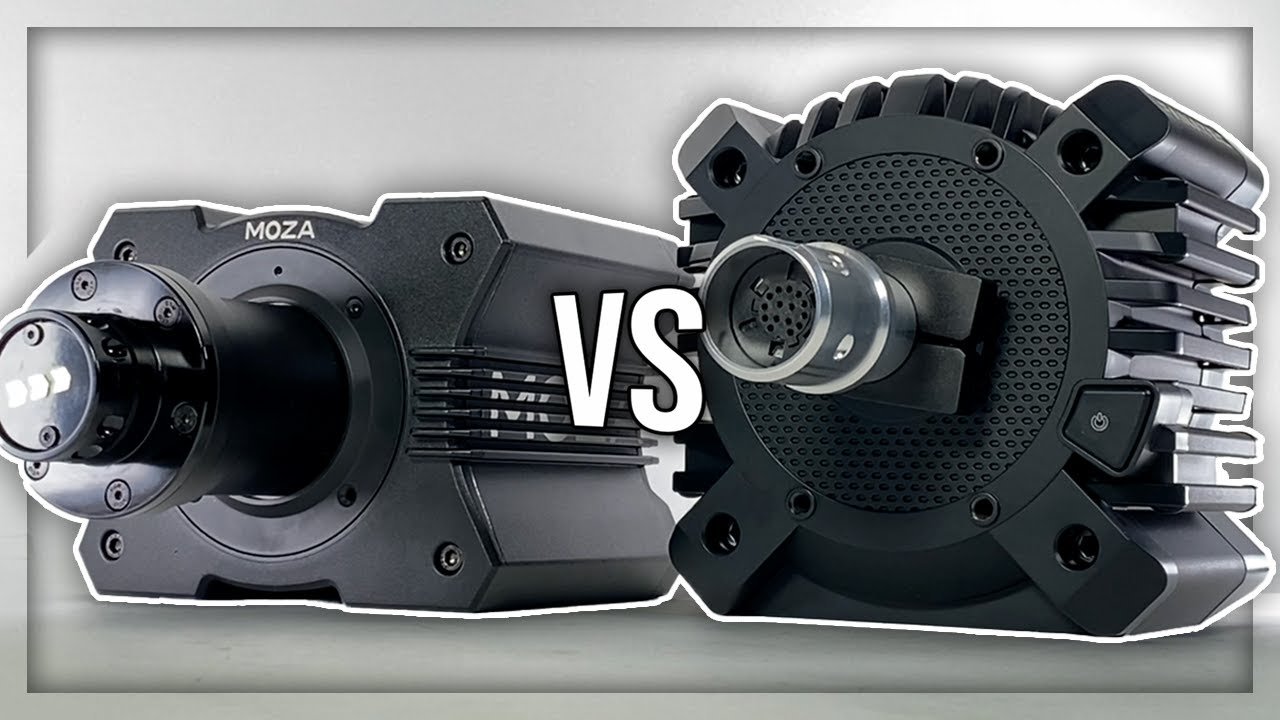Fanatec VS Moza Racing | Which is the BEST Budget Direct-Drive Wheel?!
The MOZA Racing R9 and the FANATEC CSL DD and GT DD Pro. Quite possibly the most closely matched direct-drive wheelbases in the market today, but which one is actually better? Today, I’ll be exploring just that.
Before I get started, please note that I am referring to the 8nm versions of the CSL DD and GT DD Pro (aka, the ones with the boost kit) for the entirety of this comparison. First, I’ll start by going over all of the ways the Fanatec direct-drive units are superior to the Moza R9. Then, I’ll go over all of the ways the R9 is superior to Fanatec, I’ll go over some similarities, and I’ll end by telling you which one is the better choice.
Here are all of the ways the Fanatec GT DD Pro and CSL DD are superior to the Moza Racing R9:
For starters, Fanatec with all its years in the market has established an extensive ecosystem of sim racing products. From dozens of wheel rims to a multitude of pedals to even a sim racing cockpit, they have a lot more to offer than Moza Racing which currently only has a very limited selection due to being such a new player in the market.
Complementing that, and quite possibly the biggest advantage Fanatec has over Moza right now, is that they offer far cheaper wheel rims that you can use with their direct-drive bases. Wheel rims such as the Mclaren GT3 V2 retail for $200 whereas the cheapest wheel rim currently offered by Moza costs a staggering $500. What this means, is that at this very moment, using the 8nm CSL DD with the cheapest Fanatec wheel rim will cost $700 whereas using the Moza R9 with the cheapest Moza Rim will cost $940.
Another massive bonus of the CSL DD and GT DD Pro is that they work with consoles. In the case of the CSL DD it works with Xbox and PC whereas the GT DD Pro works with PlayStation, PC, and even Xbox with a compatible wheel rim. The Moza R9 on the other hand, only works on PC. This is a massive deal for the millions of console users out there.
In terms of the actual driving experience, though the Moza R9 has more peak torque, the long industry experience and R&D Fanatec has invested into their force feedback allows the CSL DD and GT DD Pro to offer more detailed force feedback. I used the R9 and the GT DD Pro back and forth in the same sim, holding all variables constant, and though both are impressive, I have to admit that the Fanatec base provides greater precision and overall detail on track. As straight-forward as possible, it simply feels better. But that’s not to say that the R9 doesn’t, it’s just not quite on the same level, and that’s expected considering that one has been developing this technology for far longer than the other.
On a less significant note, the Fanatec wheelbases have a better mounting system that uses T-nuts and even allows for side mounting whereas the Moza R9 can only be hard-mounted with 4-bolts on the bottom.
Finally, the 5nm CSL DD (the one without the boost kit) is less expensive than the Moza R9 at $350 as opposed to $440. Granted, one has 5nm and the other 9, but regardless, it still means that Fanatec offers the cheaper entry to a direct-drive wheelbase, albeit, a less powerful one
With all that being said, here are all of the ways the Moza Racing R9 is superior to the Fanatec CSL DD and GT DD Pro:
First off, it comes standard with 9Nm of peak torque as opposed to 8nm. This means you can feel greater overall force and resistance out of your wheelbase, bumps and curbs have a bigger kick to them, and the argument could be made that it’s more immersive. So to clarify, from my own experience, and remember these are only my opinions, while I do believe the Fanatec wheelbases do a better job at transmitting fine details, the Moza R9 has a slightly greater kick to it.
Moreover, the R9 comes standard with an incredible quick-release mechanism which not only looks a lot nicer but allows you to interchange wheel rims in under 5 seconds. While the one in the CSL DD and GT DD Pro isn’t the worst I’ve ever seen, it is a lot more tedious and delicate as you have to carefully insert the wheel rim without damaging any pins and manually lock it in. So with regards to which has a better quick release, it’s not even close.
The outer casing in the GT DD Pro and CSL DD is made from aluminum with plastic used in the front and backplates. On the other hand, the Moza R9 is made entirely from aluminum. Moreover, it's also significantly smaller in size and you really get a sense of that when you see them side by side. This is significant in that it’ll give you more flexibility when closely mounting your monitors. It’s also a little bit lighter for those of you who plan to use this on a table or desk rather than a dedicated cockpit.
On a related note, it’s also offered in white or black as opposed to just black. If I’m being completely honest, I don’t know why anyone would choose a white wheelbase but at least you have the option.
Moza Racing also takes a better approach when it comes to its pricing. Unlike the controversial Fanatec boost kit which costs $150 only to unlock the full 8nm potential of your wheelbase, the R9 provides everything it can offer right out of the box without taking the… Apple-pricing-inspired approach.
Fanatec has long been criticized for how difficult it is to get their products in some parts of the world. Especially sim racers in Central and South America, Africa, and most of Asia where Fanatec does not offer shipping to. On the other hand, Moza Racing will ship you the R9 wherever you are in the world, granted shipping prices, taxes, and fees could vary. But hey, at least you can get one, am I right?
While it’s not something I’ve ever used, the Moza Racing R9 does have wireless app control where you're able to make changes to the performance of your wheelbase in the Moza app rather than having to pull up their software on your PC. This is a cool quirk of the R9 that Fanatec doesn’t have.
Finally, and everyone has been waiting for this one, is that the Moza R9 with its 9nm of peak torque is cheaper than both the CSL DD and GT DD Pro with only 8nm. The R9 retails for $440 with taxes included as opposed to the $500 price tag of the CSL DD and the $600 price tag of the GT DD Pro without sales taxes. So regarding its pricing, the R9 is less expensive and has more power than the Fanatec offerings.
Before I move onto my final decision, it’s important to walk through a few notable similarities offered by these two wheel bases.
First off, they’re both direct-drive units. You all already know this but it’s important to mention with regards to their overall capabilities. In essence, though one may be better at some things than the other, they’re still both immensely capable bits of gear.
With regards to their noise, they’re both essentially dead silent. Neither of them uses internal fans which means they make no noise when in operation.
They also follow a similar form factor in the sense that they're both small cubes. With direct drive bases coming in all shapes and sizes, these two are both small and compact.
They also both have optional table clamps that can be purchased separately. This means you can use both the Fanatec CSL DD and GT DD PRO as well as the Moza R9 on a table or flat surface if you do not have a dedicated cockpit. Keep in mind, that you’ll have to purchase that separately unless you get some type of bundle.
Final Verdict
In conclusion, I think the Moza wheelbase offers better value for money with more peak torque at a cheaper price but Fanatec offers an extensive lineup of gear and better feeling, albeit slightly less powerful force feedback. Consider all of the positives and negatives I have just mentioned and choose whichever makes the most sense considering your unique circumstances and budget. But in essence, whichever route you end up going, I can guarantee you’ll be more than happy with your decision.

